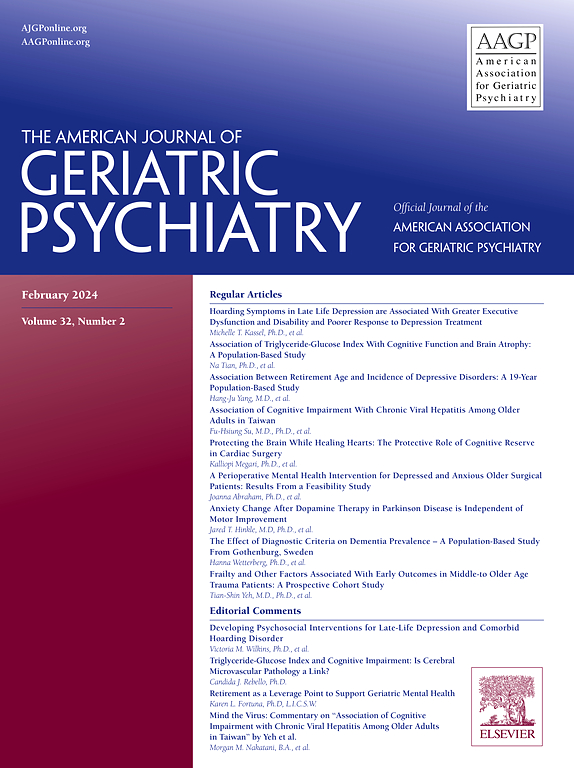Effect of Cariprazine on Outcomes in Older-aged and Younger-aged Patients with Bipolar I Disorder: A Post-hoc Analysis
IF 4.4
2区 医学
Q1 GERIATRICS & GERONTOLOGY
引用次数: 0
Abstract
Objectives
To evaluate cariprazine in adults with older- and younger-age bipolar I disorder (OABD-I and YABD-I) and compare treatment effects between them.
Design and setting
Pooled post-hoc analysis of studies in depressive or acute manic/mixed episodes associated with bipolar I disorder.
Participants
475/1383 patients (34.3%) in 3 depression trials and 238/1037 patients (23.0%) in 3 manic/mixed trials were OABD-I.
Interventions
Depression: placebo, cariprazine 1.5 mg/day, 3.0 mg/day, pooled 1.5-3.0 mg/day. Manic/mixed: placebo, cariprazine 3.0-6.0 mg/day, and 9.0-12.0 mg/day.
Measurements
Montgomery-Åsberg Depression Rating Scale (MADRS), Clinical Global Impression of Severity (CGI-S), and Young Mania Rating Scale (YMRS).
Results
In bipolar I depression, mean change from baseline in MADRS was significantly greater for the pooled cariprazine group vs. placebo in OABD-I (−13.72 vs. −11.98; p < 0.05) and for each cariprazine group vs. placebo among YABD-I. There was no significant difference in treatment effect between OABD-I and YABD-I for either individual cariprazine group vs. placebo.
For mania/mixed states, mean change in YMRS was significantly greater for cariprazine 3.0-6.0 mg/day vs. placebo in OABD-I (−19.04 vs. −12.45; p < 0.001) and for both cariprazine groups in YABD-I (−12.49, −19.66 and −18.05 for placebo, cariprazine 3.0–6.0 mg/day and 9.0–12.0 mg/day, respectively [both p < 0.0001 vs. placebo]). There was no significant difference in treatment effect between OABD-I and YABD-I for cariprazine 3.0–6.0 mg/day vs. placebo; there was a significantly higher treatment effect for cariprazine 9.0–12.0 mg/day vs. placebo in the YABD-I subpopulation vs. OABD-I (4.20; p < 0.05).
Conclusions
Cariprazine appears to be effective for both depressive and manic/mixed episodes of bipolar I disorder, regardless of age.
目的:评估卡哌嗪在老年和青年 I 型躁郁症患者(OABD-I 和 YABD-I)中的治疗效果:评估卡培拉嗪在老年和青年双相情感障碍(OABD-I和YABD-I)成人患者中的疗效,并比较两者之间的治疗效果:对与双相情感障碍I相关的抑郁或急性躁狂/混合发作的研究进行汇总后分析:3项抑郁试验中的475/1383例患者(34.3%)和3项躁狂/混合试验中的238/1037例患者(23.0%)均为OABD-I:抑郁症:安慰剂、卡哌嗪1.5毫克/天、3.0毫克/天、1.5-3.0毫克/天联用。躁狂/混合:安慰剂、卡哌嗪 3.0-6.0 毫克/天和 9.0-12.0 毫克/天:测量方法:蒙哥马利-奥斯伯格抑郁评定量表(MADRS)、临床严重程度总体印象(CGI-S)和青年躁狂评定量表(YMRS):在双相Ⅰ型抑郁症患者中,在OABD-Ⅰ型患者中,集中卡哌嗪组与安慰剂组相比,MADRS从基线开始的平均变化显著增大(-13.72 vs. -11.98;p < 0.05),在YABD-Ⅰ型患者中,卡哌嗪各组与安慰剂组相比,MADRS从基线开始的平均变化显著增大(-13.72 vs. -11.98;p < 0.05)。在OABD-I和YABD-I中,各组卡哌嗪与安慰剂的治疗效果无明显差异。就躁狂/混合状态而言,在OABD-I中,卡哌嗪3.0-6.0 mg/天与安慰剂相比,YMRS的平均变化明显更大(-19.04 vs. -12.45; p < 0.001),在YABD-I中,卡哌嗪两组的YMRS平均变化也明显更大(安慰剂、卡哌嗪3.0-6.0 mg/天和9.0-12.0 mg/天分别为-12.49、-19.66和-18.05 [与安慰剂相比,p均 < 0.0001])。卡哌嗪3.0-6.0毫克/天与安慰剂相比,OABD-I和YABD-I的治疗效果无明显差异;在YABD-I亚群中,卡哌嗪9.0-12.0毫克/天与安慰剂相比,治疗效果明显高于OABD-I(4.20;P<0.05):卡利普嗪似乎对双相情感障碍 I 的抑郁发作和躁狂/混合发作均有效,与年龄无关。
本文章由计算机程序翻译,如有差异,请以英文原文为准。
求助全文
约1分钟内获得全文
求助全文
来源期刊
CiteScore
13.00
自引率
4.20%
发文量
381
审稿时长
26 days
期刊介绍:
The American Journal of Geriatric Psychiatry is the leading source of information in the rapidly evolving field of geriatric psychiatry. This esteemed journal features peer-reviewed articles covering topics such as the diagnosis and classification of psychiatric disorders in older adults, epidemiological and biological correlates of mental health in the elderly, and psychopharmacology and other somatic treatments. Published twelve times a year, the journal serves as an authoritative resource for professionals in the field.

 求助内容:
求助内容: 应助结果提醒方式:
应助结果提醒方式:


